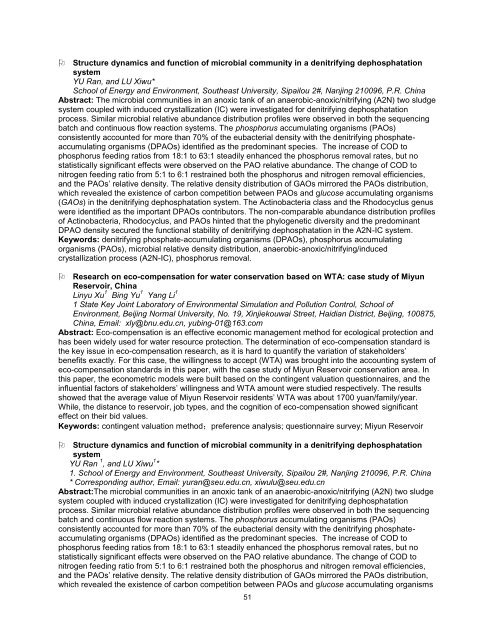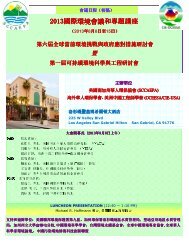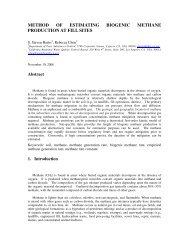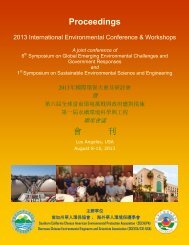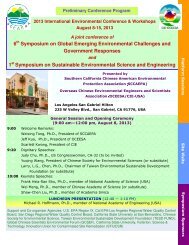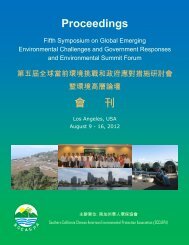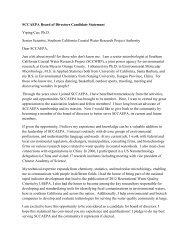Proceedings æ å - SCCAEPA SPONSORS
Proceedings æ å - SCCAEPA SPONSORS
Proceedings æ å - SCCAEPA SPONSORS
Create successful ePaper yourself
Turn your PDF publications into a flip-book with our unique Google optimized e-Paper software.
Structure dynamics and function of microbial community in a denitrifying dephosphatation<br />
system<br />
YU Ran, and LU Xiwu*<br />
School of Energy and Environment, Southeast University, Sipailou 2#, Nanjing 210096, P.R. China<br />
Abstract: The microbial communities in an anoxic tank of an anaerobic-anoxic/nitrifying (A2N) two sludge<br />
system coupled with induced crystallization (IC) were investigated for denitrifying dephosphatation<br />
process. Similar microbial relative abundance distribution profiles were observed in both the sequencing<br />
batch and continuous flow reaction systems. The phosphorus accumulating organisms (PAOs)<br />
consistently accounted for more than 70% of the eubacterial density with the denitrifying phosphateaccumulating<br />
organisms (DPAOs) identified as the predominant species. The increase of COD to<br />
phosphorus feeding ratios from 18:1 to 63:1 steadily enhanced the phosphorus removal rates, but no<br />
statistically significant effects were observed on the PAO relative abundance. The change of COD to<br />
nitrogen feeding ratio from 5:1 to 6:1 restrained both the phosphorus and nitrogen removal efficiencies,<br />
and the PAOs‟ relative density. The relative density distribution of GAOs mirrored the PAOs distribution,<br />
which revealed the existence of carbon competition between PAOs and glucose accumulating organisms<br />
(GAOs) in the denitrifying dephosphatation system. The Actinobacteria class and the Rhodocyclus genus<br />
were identified as the important DPAOs contributors. The non-comparable abundance distribution profiles<br />
of Actinobacteria, Rhodocyclus, and PAOs hinted that the phylogenetic diversity and the predominant<br />
DPAO density secured the functional stability of denitrifying dephosphatation in the A2N-IC system.<br />
Keywords: denitrifying phosphate-accumulating organisms (DPAOs), phosphorus accumulating<br />
organisms (PAOs), microbial relative density distribution, anaerobic-anoxic/nitrifying/induced<br />
crystallization process (A2N-IC), phosphorus removal.<br />
Research on eco-compensation for water conservation based on WTA: case study of Miyun<br />
Reservoir, China<br />
Linyu Xu 1 Bing Yu 1 Yang Li 1<br />
1 State Key Joint Laboratory of Environmental Simulation and Pollution Control, School of<br />
Environment, Beijing Normal University, No. 19, Xinjiekouwai Street, Haidian District, Beijing, 100875,<br />
China, Email: xly@bnu.edu.cn, yubing-01@163.com<br />
Abstract: Eco-compensation is an effective economic management method for ecological protection and<br />
has been widely used for water resource protection. The determination of eco-compensation standard is<br />
the key issue in eco-compensation research, as it is hard to quantify the variation of stakeholders‟<br />
benefits exactly. For this case, the willingness to accept (WTA) was brought into the accounting system of<br />
eco-compensation standards in this paper, with the case study of Miyun Reservoir conservation area. In<br />
this paper, the econometric models were built based on the contingent valuation questionnaires, and the<br />
influential factors of stakeholders‟ willingness and WTA amount were studied respectively. The results<br />
showed that the average value of Miyun Reservoir residents‟ WTA was about 1700 yuan/family/year.<br />
While, the distance to reservoir, job types, and the cognition of eco-compensation showed significant<br />
effect on their bid values.<br />
Keywords: contingent valuation method;preference analysis; questionnaire survey; Miyun Reservoir<br />
Structure dynamics and function of microbial community in a denitrifying dephosphatation<br />
system<br />
YU Ran 1 , and LU Xiwu 1 *<br />
1. School of Energy and Environment, Southeast University, Sipailou 2#, Nanjing 210096, P.R. China<br />
* Corresponding author, Email: yuran@seu.edu.cn, xiwulu@seu.edu.cn<br />
Abstract:The microbial communities in an anoxic tank of an anaerobic-anoxic/nitrifying (A2N) two sludge<br />
system coupled with induced crystallization (IC) were investigated for denitrifying dephosphatation<br />
process. Similar microbial relative abundance distribution profiles were observed in both the sequencing<br />
batch and continuous flow reaction systems. The phosphorus accumulating organisms (PAOs)<br />
consistently accounted for more than 70% of the eubacterial density with the denitrifying phosphateaccumulating<br />
organisms (DPAOs) identified as the predominant species. The increase of COD to<br />
phosphorus feeding ratios from 18:1 to 63:1 steadily enhanced the phosphorus removal rates, but no<br />
statistically significant effects were observed on the PAO relative abundance. The change of COD to<br />
nitrogen feeding ratio from 5:1 to 6:1 restrained both the phosphorus and nitrogen removal efficiencies,<br />
and the PAOs‟ relative density. The relative density distribution of GAOs mirrored the PAOs distribution,<br />
which revealed the existence of carbon competition between PAOs and glucose accumulating organisms<br />
51


